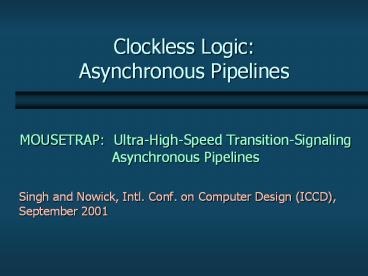Clockless Logic: Asynchronous Pipelines - PowerPoint PPT Presentation
Title:
Clockless Logic: Asynchronous Pipelines
Description:
Clockless Logic: Asynchronous Pipelines MOUSETRAP: Ultra-High-Speed Transition-Signaling Asynchronous Pipelines Singh and Nowick, Intl. Conf. on Computer Design (ICCD ... – PowerPoint PPT presentation
Number of Views:188
Avg rating:3.0/5.0
Title: Clockless Logic: Asynchronous Pipelines
1
Clockless Logic Asynchronous Pipelines
- MOUSETRAP Ultra-High-Speed Transition-Signaling
Asynchronous Pipelines - Singh and Nowick, Intl. Conf. on Computer Design
(ICCD), September 2001
2
MOUSETRAP Pipelines
- Simple asynchronous implementation style, uses
- transparent latches
- simple control 1 gate/pipeline stage
- Target datapath static logic blocks
- MOUSETRAP uses a capture protocol
- Latches
- are normally transparent before new data
arrives - become opaque after data arrives (capture
data) - Control Signaling transition-signaling
2-phase - simple protocol req/ack only 2 events per
handshake (not 4) - no return-to-zero
- each transition (up/down) signals a distinct
operation - Our Goal very fast cycle time
- simple inter-stage communication
3
MOUSETRAP A Basic FIFO
- Stages communicate using transition-signaling
Latch Controller
1 transition per data item!
ackN-1
ackN
En
doneN
reqN
reqN1
Data in
Data out
Data Latch
Stage N
Stage N-1
Stage N1
2nd data item flowing through the pipeline
1st data item flowing through the pipeline
1st data item flowing through the pipeline
4
MOUSETRAP A Basic FIFO (contd.)
- Latch controller (XNOR) acts as phase
converter - 2 distinct transitions (up or down) ? pulsed
latch enable
Latch Controller
2 transitions per latch cycle
ackN-1
ackN
En
reqN
reqN1
doneN
Data in
Data out
Data Latch
Stage N
Stage N-1
Stage N1
5
MOUSETRAP FIFO Cycle Time
N re-enabled to compute
N1 computes
N computes
6
Detailed Controller Operation
Stage Ns Latch Controller
ack from N1
done from N
to Latch
- One pulse per data item flowing through
- down transition caused by done of N
- up transition caused by done of N1
- No minimum pulse width constraint!
- simply, down transition should start early
enough - can be negative width (no pulse!)
7
MOUSETRAP Pipeline With Logic
Simple Extension to FIFO insert logic block
matching delay in each stage
Latch Controller
ackN-1
ackN
reqN1
reqN
delay
delay
delay
doneN
Data Latch
Stage N1
Stage N
Stage N-1
- Logic Blocks can use standard single-rail
(non-hazard-free) - Bundled Data Requirement
- each req must arrive after data inputs valid
and stable
8
Special Case Using Clocked Logic
- Clocked-CMOS C2MOS eliminate explicit latches
- latch folded into logic itself
C2MOS AND-gate
9
Gate-Level MOUSETRAP with C2MOS
Latch Controller
- Use C2MOS eliminate explicit latches
- New Control Optimization Dual-Rail XNOR
- eliminate 2 inverters from critical path
ackN-1
ackN
2
2
2
doneN
2
2
reqN
reqN1
pair of bit latches
C2MOS logic
Stage N
Stage N-1
Stage N1
10
Complex Pipelining Forks Joins
- Problems with Linear Pipelining
- handles limited applications real systems are
more complex
- Contribution introduce efficient circuit
structures - Forks distribute data control to multiple
destinations - Joins merge data control from multiple sources
- Enabling technology for building complex async
systems
11
Forks and Joins Implementation
Join merge multiple requests
Fork merge multiple acknowledges
12
Related Protocols
- Day/Woods (97), and Charlie Boxes (00)
- Similarities all use
- transition signaling for handshakes
- phase conversion for latch signals
- Differences MOUSETRAP has
- higher throughput
- ability to handle fork/join datapaths
- more aggressive timing, less insensitivity to
delays
13
Performance, Timing and Optzn.
- MOUSETRAP with Logic
MOUSETRAP Using C2MOS Gates
14
Timing Analysis
- Main Timing Constraint avoid data overrun
- Data must be safely captured by Stage N
- before new inputs arrive from Stage N-1
- simple 1-sided timing constraint fast latch
disable - Stage Ns self-loop faster than entire path
through previous stage
15
Timing Optzn Reducing Cycle Time
- Analytical Cycle Time
- Goal shorten (in steady-state
operation) - Steady-state no undue pipeline congestion
- Observation
- XNOR switches twice per data item
- only 2nd (up) transition critical for
performance - Solution reduce XNOR output swing
- degrade slew for start of pulse
- allows quick pulse completion faster rise time
- Still safe when congested pulse starts on time
- pulse maintained until congestion clears
16
Timing Optzn (contd.)
N done
N1 done
latch only partly disabled recovers
quicker! (no pulse width requirement)
17
Comparison with Wave Pipelining
- Two Scenarios
- Steady State
- both MOUSETRAP and wave pipelines act like
transparent flow through combinational
pipelines - Congestion
- right environment stalls each MOUSETRAP stage
safely captures data - internal stage slow MOUSETRAP stages to its left
safely capture data - ? congestion properly handled in MOUSETRAP
- Conclusion MOUSETRAP has potential of
- speed of wave pipelining
- greater robustness and flexibility
18
Timing Issues Handling Wide Datapaths
- Buffers inserted to amplify latch signals (En)
- Reducing Impact of Buffers
- control uses unbuffered signals
- ? buffer delay off of critical
path! - datapath skewed w.r.t. control
- Timing assumption
- buffer delays roughly equal
19
(No Transcript)
20
Preliminary Results
- Pre-Layout Simulations of FIFOs
- do not account for wire delays, parasitics, etc.
- careful transistor sizing/verification of timing
constraints
21
Conclusions and Future Work
- Introduced a new asynchronous pipeline style
- Static logic blocks
- Simple latches and control
- transparent latches, or C2MOS gates
- single gate control 1 XNOR gate/stage
- Highly concurrent event-driven protocol
- High throughputs obtained
- 3.5 GHz in 0.25?, 1.9 GHz in 0.6?
- comparable to wave pipelines yet more
robust/less design effort - Correctly handle forks and joins in datapaths
- Timing constrains local, 1-sided, easily met
- Ongoing Work
- more realistic performance measurement (incl.
parasitics) - layout and fabrication































